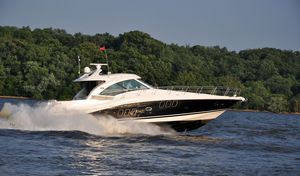Some people just love boating. There are those who can spend an entire day out on the water, soaking up the sun, enjoying the wind in their face and that exhilarating feeling that only being on a boat can elicit.
Other folks like to head down to the marina on Friday night, climb aboard their boat and spend an entire weekend enjoying the local waters, checking out different marinas and the restaurants and nightlife, and returning to their Fiberglass cocoon each evening to enjoy a couple of nights of peaceful slumber as the gentle sounds of the water lapping against the hull soothe them to sleep.
Still others will clear their calendar for an adventurous one- or two-week voyage that takes them to never-before traveled destinations. They make new friends, explore unknown ports and harbors, enjoy fantastic scenery, and fill their cameras and DVD recorders with memories to last a lifetime, all the while expanding upon the knowledge of their vessel and the open water, and their level of confidence as the captain of their ship.
And then there are Loopers.
Loopers are a different breed. Loopers don’t bag out of work on a Friday, or kennel the dog for the weekend, or make a trip to the Post Office and ask them to hold their mail for a couple of weeks. No, no – Loopers are hardcore. Loopers like to go the distance – literally.
If you’re known as a ‘Looper’, you are either planning , actively cruising or have already completed, at least in part, one of the most exciting and rewarding experiences known to boaters – cruising America’s Great Loop.
America’s Great Loop is a journey that can take you some 5500 to 6000 miles from start to finish, depending on the decisions you make along the way. The Great Loop is traveled in a counter-clockwise direction, and it takes you up the East Coast, across Eastern Canada and the Great Lakes, down the Mighty Mississippi and across the Gulf of Mexico. Much like a merry-go-round, You can start wherever you want and stop wherever you want – complete then entire journey or only a portion of the loop. The length of your voyage will depend on several factors, including the weather and your available resources – financial, physical and emotional.
Most folks who have completed the entire journey like to finish up the trip in the exact same spot that they started, otherwise known as ‘crossing your wake’. Other Loopers choose to cruise only a portion of the Loop for various reasons – limited resources, time of year, available free time, etc. The Loop can be made in one continuous trip, or it can be done in shorter stretches that span several years. The options are virtually endless when planning to cruise the Great Loop. The important thing to remember is that it’s not a race, but rather an experience to be savored and enjoyed to the fullest, and something you should feel free to make your own.
Deciding to cruise the Great Loop is not a decision that is made lightly. You don’t just wake up one morning, look across the table over your morning coffee and say, ‘Honey! I have a great idea! Let’s cruise the Great Loop!’ There is a good deal of planning that goes into a trip of this magnitude and a lot to consider. Why? Well, for starters, if you have designs on completing the Great Loop in one trip, you better plan on spending the better part of a year out on the water. Some cruisers have completed the entire circuit in as little as 7 months, but the average duration is upwards of 12.
You might be asking yourself, ‘Why counter-clockwise? Why can’t I go in the other direction?’ Well, technically you could, but you better have a boatload of cash (all puns intended) for fuel and boat repairs if you want to tackle the fierce currents of the Illinois, Ohio and Mississippi Rivers cruising upstream. Cruising downstream just makes more sense – it is far more economical, and a whole lot easier on your boat. Same thing goes for the Gulf, and even cruising up the East Coast – letting the Gulf Stream do some of the work can significantly minimize your fuel costs.
Your next question might be, ‘So what kind of boat would I need? The bigger, the better, right?’ Well, no, not necessarily. For one thing, the bigger the boat, the higher your fuel consumption will be, and when you’re planning a 6000 mile trip on your boat, fuel consumption will be your single biggest expense.
By far, the most popular type of boat to cruise the Great Loop is the trawler, because of its shallow draft and overall comfort. Remember, you’re going to be spending a significant amount of time on board, so being comfortable can become an extremely important factor in deciding on what type of boat will be best for you. The vast majority of Loopers are couples, so be sure that you will both have the amenities that you need to keep the trip enjoyable for the two of you.
The single most important factor to keep in mind when thinking of an appropriate boat to cruise the Great Loop is it’s overall height above the water line – anything over 19′ and you will not be able to complete the entire Loop, plain and simple. The reason for this is that 19′ is the absolute limit at the low fixed bridge at mile 300 of the Illinois Waterway out of Chicago and there is no getting around it.
That’s not to say that the bridge at mile 300 is the lowest – there are still others that are even lower – however you can adjust your route to avoid them. If your boat clears 15′ 6″, then you will be able to enjoy cruising the entire Great Loop with no restrictions – any route you decide will accommodate the height of your vessel.
The draft of your vessel should not really be a problem, but ideally it should be 5′ or less. Some cruisers who have completed the Great Loop would say that for the most carefree cruising, 4′ or less is perfect. You can probably push the envelope and make it with a draft of up to 6′, but it’s going to require spending a lot more time concentrating on your maps, GPS navigation and depth finder to avoid any surprises along the way.
If your trip plans include spending time at marinas along the route, the ideal size for your vessel’s beam will be 13′ or less, because there aren’t too many marinas that offer slips for wider boats, such as Catamarans, so the wider your boat, the fewer marina choices you will have. If you plan on spending most of your nights out on the hook, then the only other beam restriction to keep in mind will be the 23′ width at the entrance to Port Severn in Canada. This Lock has the smallest width restriction on the Great Loop, however it can be avoided.
By now you’re probably wondering, ‘So what’s this Great Loop experience going to cost me?’ The overall cost of cruising the Great Loop will depend heavily on two important factors – the size of your vessel (and type/size/number of engines), and your individual lifestyle. Do you plan on spending most of your free time at port dining out at restaurants and perhaps staying at several hotels along the way? Do you plan on visiting many of the more popular and exciting ports and enjoying the local culture and exciting nightlife each port has to offer? If so, you’re probably going to spend a good deal more than those who choose to ‘live-aboard’ – using their vessel as their primary domicile, living off the catch of the day, and spending the majority of their free time enjoying the sights and scenery from the water. There is certainly no right or wrong way to do it – it is simply a matter of lifestyle preferences and financial resources.
Some of the basic expenses you will need to factor into planning your Great Loop Cruise will include:
a) Dock/slip fees and related expenses
b) Utilities (cell phone/Internet)
c) Fuel (remember to factor in the cost of cooking and running the generator for AC and heat)
d) Maintenance (preventive and emergency)
e) Insurance
f) Entertainment
g) Basic needs (food, personal care needs and clothing)
There may be other expenses to consider as well, depending on the route you take, such as a Locking Pass fee (a one-way transient pass at $4.65 per lineal foot of boat length) to travel through the numerous Locks across Canada.
One final point to keep in mind when planning your cruise around the Great Loop is the time of year you will be traveling. Cruising the entire Great Loop will take you from the tropics in the south, to the much cooler Great Lakes and Canada in the north, so it is critical that you bear in mind the seasonal extremes you are going to encounter while cruising through these regions of the country. There are particular areas that you definitely want to avoid at certain times of the year. For example, you don’t want to be cruising down across the Gulf during hurricane season, and you definitely don’t want to travel across Canada in the dead of winter (in fact you can’t – canals and Locks close and lakes freeze). A general rule of thumb is to plan to cruise the southern part of the Loop during the winter months and the northern part of the Loop during the summer months.
There is a wealth of information that can be found online about cruising the Great Loop. You can check out the Captain’s Quarters for detailed information on the various segments of the trip, as well as some solid, first-hand advice and other interesting facts. Another excellent resource is America’s Great Loop Cruisers Association, or AGLCA. What to expect Cruising America’s Great Loop will provide you with blogs and other resources that can be very useful in planning your Great Loop adventure. So get busy – there is a lot of work that goes into planning the trip of a lifetime – a trip you will want to experience again and again.



